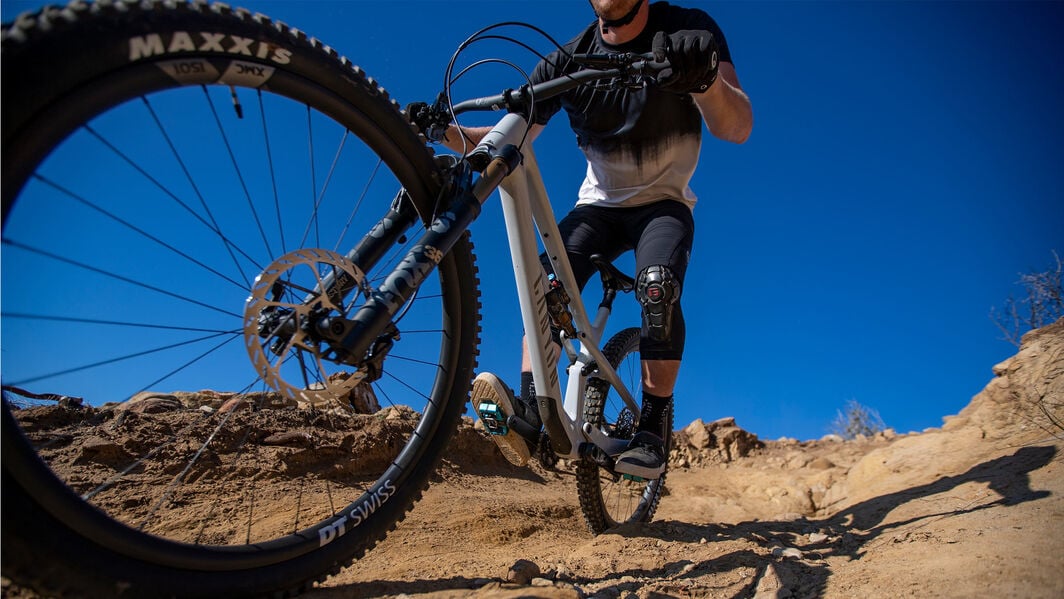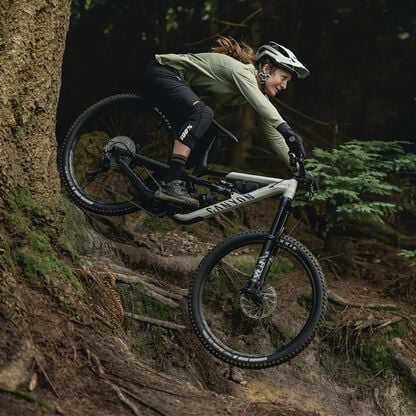Mountain bike tyre pressure: Master the perfect setup for every trail
Getting the right MTB tyre pressure could be the difference between a great ride and a disastrous one. Your tyres are your sole contact point with the trail, so dialling in the way they ride is crucial.


Perfecting the tyre pressure on your mountain bike is no easy feat. So many factors affect the pressure you should put in your tyres before you ride. From trail conditions to rider weight, the subject of tyre pressure is where science and dark art combine.
We spoke to some of our colleagues and athletes to get their opinion on what you should do when it comes to mountain bike tyre pressure.
“In general, there isn’t a "one size fits all" tyre pressure to recommend,” says Larry Hartwich, our pro sports manager for our gravity athletes. “It all depends on your position on the bike, the weather and terrain, not to mention the specific tyres you ride. Beginning with a pressure of 23/24psi in the front and 27/28psi in the rear can be a good starting point if you’re running tubeless and you can adjust as needed.”
Having worked with professional athletes for much of his career, Larry knows a thing or two about optimising tyre pressure. In this article, we’ll discuss a few of the key points you need to consider before you reach for your pump.
Contents
MTB tyre pressure is personal
The world of mountain bikes has makes and models of all sorts. From our light and fast cross-country MTB, the Exceed, to our enduro mountain bike, the Strive, each bike is specially made for a certain ride style, each requiring you to set your bike tyre psi slightly differently for the best experience.
Your own preferences also play a part in MTB tyre pressure magic. What works for your riding buddies, might not work for you. While it’s great to have their opinion, it’s important to experiment and make the right choice for you.
So, there is no hard and fast rule that will suit every rider for every bike. However, we can point you in the right direction to find the right mountain bike tyre pressure for you.
Tweaking your mountain bike tyre pressure to suit ride style and trail conditions
Whether you’re riding flowy cross-country singletrack or hitting more technical trails, your type and style of riding will dictate what bike tyre psi you ought to use. Canyon athlete Braydon Bringhurst rides the following pressure (tubeless) when on trails:
Front: 28psi (1.93 bar)
Rear: 30psi (2.07 bar)
The above is a good place to start for general trail riding with a tubeless setup. This works for most types of trail riding ranging from singletrack to enduro style riding. While MTB tyre pressures may seem low to a road rider, they allow the tyre to better absorb smaller bumps from rocks and trail features than a harder tyre, acting as a ‘micro suspension,’ making the overall ride experience more enjoyable.
Like tuning suspension to rider weight, you should also take rider weight into account when inflating your tyres. Riders over 80kg will exert more force on the tyres, whereas lighter riders will exert less force on the tyres. Canyon’s own Scott Hart, a lighter rider, rides trails on his Torque set up to the following:
Front: 25psi (1.72 bar)
Rear: 27psi (1.86 bar)
As you can see, Scott rides a few psi lower than Braydon. Heavier and more aggressive riders may need to inflate their front/rear mountain bike tyre pressure to 30/32psi, respectively. Most tyre manufacturers will have tyre pressures printed on the tyres themselves (assuming tubeless setup) as ranges; don’t go below the printed minimum pressure or above the maximum (generally 20-40psi).
Too little air may result in rolling or what we refer to as ‘burping’ the tyre. Burping happens when you corner your bike too hard for the air pressure in the tyres. The resulting ‘psst!’ shows that the tyre is deforming too much under load and letting a little air out through the bead and wheel rim.
If you find you’re burping, pump your tyres up until you can corner hard without that telltale sound.
If your bike tyre psi is set too high it may result in losing grip and skittering over the surface of the trail rather than the tyre’s side knobs digging into it.
Riding dry, sandy trails is quite different to riding muddy or loamy trails elsewhere. As a result, your tyres should be set up accordingly. If the course is wet or loose, run your tyres 2-3psi lower than when the same trails are dry. This will give you better grip on loose, wet corners.
If you’re racing in dryer conditions on grippy terrain, try inflating your tyres to 35psi if the conditions are perfect. This will result in your tyres running a lot faster and potentially giving you the winning edge. Although on rocky, sharp or square edged trails you might want to go even higher to avoid denting (or dinging) your rims.
Hardtail mountain bike vs full suspension mountain bike tyre pressure
Mountain bike tyre pressure is critical in the performance of both hardtail and full-suspension mountain bikes, directly affecting grip, comfort, and control.
Hardtail bikes typically require lower bike tyre psi due to their lack of rear suspension, which means they rely on tyres for shock absorption. For most riders, front pressures range from 22 to 28psi, while rear pressures are slightly higher, between 24 and 30psi. This setup provides improved grip and comfort on rough terrain while minimising the risk of pinch flats.
Full-suspension bikes, with their additional rear shock, allow for slightly higher pressures as the suspension absorbs much of the impact. Front pressures typically range from 24 to 30psi, and rear pressures from 26 to 32psi. Higher pressures reduce rolling resistance on smoother trails, while slightly lower settings enhance grip and control on technical or loose surfaces.
Tyre type and width also influence these ranges. Wider tyres or tubeless setups allow for lower pressures without sacrificing performance or risking flats. Hardtail riders benefit from this extra cushioning, especially on rocky or root-filled trails, while full-suspension riders can tune their pressures to complement the bike's suspension system.
For rocky or uneven terrain, a hardtail might run 23psi front and 25psi rear, while a full-suspension bike might use 25psi front and 27psi rear. On smoother trails, pressures could increase by 2–4psi for both bike types to optimise rolling efficiency. Fine-tuning within these ranges is essential for achieving the best performance.
Experimentation is key to optimising tyre pressure for each bike and trail combination.

Tube or tubeless? The right MTB tyre pressure for your setup
Tubeless tyres are tyres that use sealant and tubeless valves to keep the air in the tyre, negating the need for an inner tube. Without an inner tube, tubeless tyres are resistant to pinch flats (when you pinch the inner tube between the rim and tyre). And, as the sealant will fill small holes are generally more puncture resistant.
If you are running inner tubes (all Canyon bikes are shipped with inner tubes) then you should pump your tyres 5psi higher than what we recommended above. As a general place to start, inflate inner tube tyres to the following:
Front: 33psi (2.28bar)
Rear: 35psi (2.41bar)
Tubeless tyres also allow you to run quite low pressures safely, because there is no tube to pinch flat. For increased grip, lower your pressure by 5psi, but keep in mind, you are at a greater risk for burping the rim and losing sealant or rolling the tyre. Never run your tyres below the minimum pressure printed on the side of the tyre.
| Pros | Cons | |
|---|---|---|
| Tubeless | No pinch flats because there’s no inner tube to get pinched. | Risk of tyre ‘burping’ if run at too low a pressure. |
| Generally more puncture resistant and ability to ‘self heal’ small and mid-sized holes. | Messy and more complex to set up, and often requiring more advanced tools. | |
| Can be run at lower pressures, which has a beneficial impact on grip. Difficult to fix on the trailside in the rare cases where the system fully fails (huge sidewall tear, failure to seal holes, running out of sealant). | Difficult to fix on the trailside in the rare cases where the system fully fails (huge sidewall tear, failure to seal holes, running out of sealant). | |
| Tubes | Quick and easy to setup, and simpler to fix in the event of a puncture. | If you run them at too low a pressure there is a risk of pinch flats when you hit obstacles. |
| Cheap to maintain, particularly if you repair and reuse your punctured tubes. | Increased pressure required to run them safely detracts from the amount of grip they can give. |
Wondering when to change your mountain bike tires and how to do it? Check out our advisor for expert tips and step-by-step instructions to keep your ride in top shape.

How to find the perfect mountain bike tyre pressure
In short, we recommend beginner trail riders start with the following pressures on tubeless tyres:
Front: 27psi (1.86bar)
Rear: 30psi (2.07bar)
If your tyres are running inner tubes, try starting with this pressure:
Front: 32psi (2.21bar)
Rear: 35psi (2.41bar)
| Front | Rear | |
|---|---|---|
| Beginner rider using tubeless setup | 27psi / 1.86bar | 30psi / 2.07bar |
| Beginner rider using inner tubes | 32-33psi / 2.21-2.28bar | 35psi / 2.41bar |
| Canyon athlete Braydon Bringhurst riding trails, tubeless | 28psi / 1.93bar | 30psi / 2.07bar |
| A lighter, experienced amateur rider on an enduro bike | 25psi / 1.72bar | 27psi / 1.86bar |
Spend a few rides getting used to how the bike feels with those pressures. Take a pump with you on your rides if you want to experiment with higher or lower pressures. There’s no exact answer, so playing around with what works best for you will be the best way to dial in your Canyon.
If you’re burping your tubeless tyres or pinch flatting tubes you’ve set your tyre pressures too low. If you’re struggling to find grip in the corners you’ve gone too high.
How does MTB wheel size change tyre pressure? So far we’ve mostly been talking tyre pressure for 29” MTB tyres. 27.5” MTB tyres (found on the rear wheels of our mullet bikes and some of our smaller mountain bikes) will run the same pressures. The real difference in pressure comes from changes in tyre width, but not necessarily tyre diameter. So as a rule of thumb, be sure to inflate 27.5” wheels roughly the same as a 29” tyre and adjust according to preference and conditions.
Larry's MTB tyre pressure advice
Once you know where you’re riding and your desired pressure, you can start doing a bit of trial and error.
“A small increase or decrease can mean a lot,” advises Larry when experimenting with pressure. “Pay attention to your tyres and their pressure and you’ll have more fun on your bike.”
One final tip from Larry if you’re really passionate about honing your tyre pressure: “Use a tyre pressure gauge instead of your pump’s scale. This way you can make sure no matter which pump you use, you’ll always have your preferred pressure.”
Discover our Mountain Bikes
Did this article help?
Thank you for your feedback
















